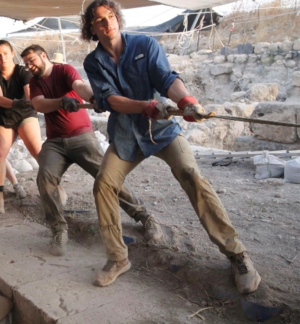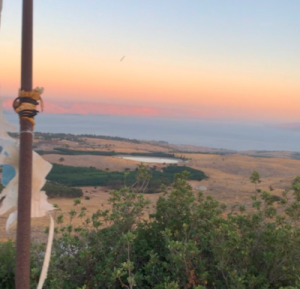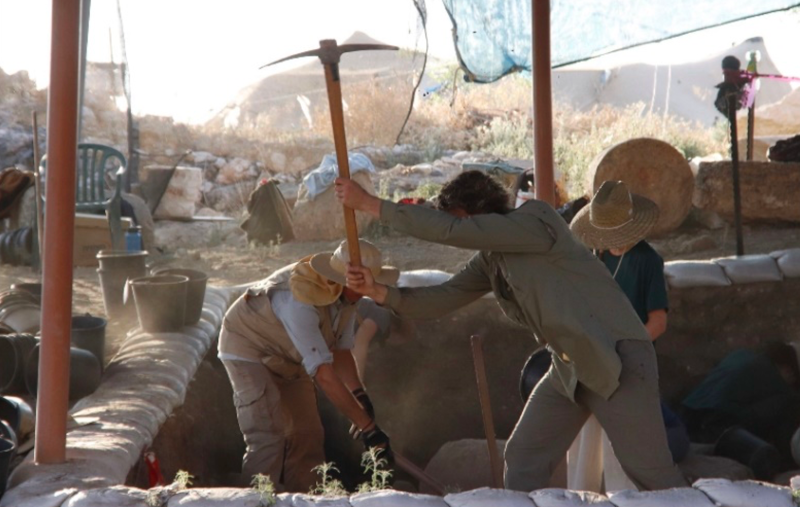
A Day in the Life: Huqoq Excavation
Firstly, I would like to thank both ASOR and the donors who provided this scholarship; I would not have been able to have this great experience without their support.
This summer I was apart of the Huqoq 2022 field season, directed by Dr. Jodi Magness from the University of North Carolina. Huqoq was a Jewish village, containing a monumental synagogue built in the 5th century CE, which sits upon a hill northwest of the Sea of Galilee. This synagogue, notable for its many well preserved floor mosaics, was the focus of the excavation.
A typical day in the life at Huqoq involved waking up at 4am, taking a bus, and then finally a short hike to the excavation site. Our hike to and from the site was quite literally uphill both ways but the stary sky in the morning and the conversations on the way back always made it worthwhile. Once we set up the site we were ready to excavate until 8am. From there we would have a five-star field breakfast with eggs, pancakes, fruit, and a variety of local foods as well. With this boost from breakfast we would once again be hard at work until 11am, where we would then have a fruit break, which we called “elevensies”, before going back to work finishing up the day’s excavation and then getting ready to leave around 12:30pm. We then would then hike back uphill to the busses and have lunch at the kibbutz we were staying at.

While we were excavating, I worked in the area east of the synagogue. On our site following the destruction of the late roman synagogue, a medieval synagogue was built over the previous building using some of the walls of the previous synagogue and expanding them elsewhere. In the eastern area, where I was working, in previous seasons they had discovered a medieval vaulted structure, close to the eastern wall of the medieval synagogue.
Due to this find when excavating we expected to find further evidence of this medieval structure, and thought that this may have been a pilgrimage site for those wishing to see the tomb of the prophet Habakkuk, one of the 12 minor prophets in the Hebrew Bible. While we have not yet found any direct evidence of the Medieval vaulted structure being a pilgrimage site for the tomb of Habakkuk -we liked to joke that we would find a sarcophagus with the inscription “Here Lies Habakkuk” – while digging we made an unexpected but maybe even more exciting discovery connected to the late Roman synagogue, which is all I can mention here.
However, if you are interested, please visit the Huqoq site’s website where they will post updates when there is a publication: Huqoq Excavation Project (unc.edu).

Additionally I was able to see many important sights within Israel including Capernaum, Sepphoris, Caesarea, Tel Dan, Banyas, and Megiddo, to name a few. Being a student of Koine Greek, it was amazing to visit and see some of the places which I had only read about. This gave me a deeper appreciation and understanding of these stories as it left me in awe, as simply looking off into the distance at our excavations there were sights of important historical events or locations of biblical stories.
Also, during the excavation new sections of the floor mosaics from the late Roman synagogue were unearthed, which were fascinating. I will not touch on them here but please see this link if you are interested: Excavations by Carolina archaeologist reveal first known depictions of two biblical heroines, episode in ancient Jewish art | UNC-Chapel Hill.
Cayden Griffith is currently a senior at Austin college where he is majoring in Classics, Anthropology, and History.
American Society of Overseas Research
The James F. Strange Center
209 Commerce Street
Alexandria, VA 22314
E-mail: info@asor.org
© 2023 ASOR
All rights reserved.
Images licensed under a Creative Commons Attribution-NonCommercial-ShareAlike 4.0 International License
COVID-19 Update: Please consider making payments or gifts on our secure Online Portal. Please e-mail info@asor.org if you have questions or need help.

